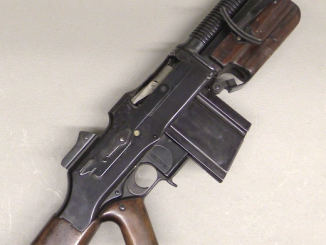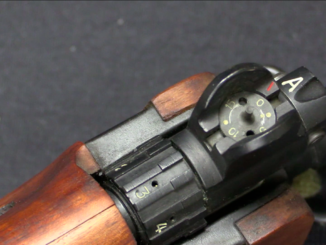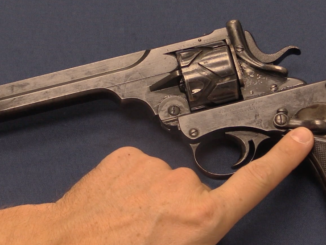After World War Two, the Belgian military wanted to replace its many Sten guns with a better standard SMG. The solution was designed by Colonel Georges Vigneron in 1953, and adopted by all branches of the Belgian military (as well as the Force Publique in the Belgian Congo) in 1954. This is a very simple blowback SMG, and cheap to manufacture. It has a 3-position combined safety/selector switch to allow semiauto fire, and a grip safety which locks the bolt in position when both cocked and uncocked. The M2 was a relatively minor improvement to the original M1, focused primarily on the sights, replacing a rear aperture with an open notch and adding a protective guard to the front. In total, more than 100,000 Vignerons were manufactured, and they remained in Belgian service into the 1990s. The gun was considered effective and reliable, and generally quite well regarded despite its inexpensive nature.
Related Articles

Light MGs
FN Model 30: The First Belgian BAR

Semiauto Rifles


If I’m not mistaken it’s somewhat unusual to see a compensator on the submachinegun. If there’s going to be a range video for this it will be interesting to see what kind of affect it has.
Somewhat, but not extremely rare. Original Thompson, Reising, PPSh, PPD, etc.
It was widespread in 1940s sub-machine guns. Beyond mentioned Soviet design, other examples are: Beretta 1938 (Kingdom of Italy), OWEN machine carbine (Australia), Halcon M/943 (Argentina). This also apply to early production STEN, see 1st photo from top https://modernfirearms.net/en/submachine-guns/great-britain-submachine-guns/sten-eng/
https://modernfirearms.net/en/submachine-guns/belgium-submachine-guns/vigneron-m2-eng/ notes that It is interesting that in full automatic mode short pull on the trigger will still, produce single shots, and only a long pull will produce full automatic fire.. Do you know any other weapon working in this manner (i.e. featuring both fire selector and pull-dependent fire mode)?
I ad one issued in 1965 during my military service, as you said well liked and a solid improvement over the Sten. however the lack of locking for the barrel nut and receveir end cap posed some problem, one ad to squeze both very thigh or they could unscrew during fire , the barrel nut mostly.
Didn’t some of these turn up in Rhodesia?
Some did make their way over the border into Northern Rhodesia during the Congo Crisis. I’m not aware of Zimbabwe insurgent forces using them, however, though I would not be surprised. MAT Mle. 49s made an appearance during the Bush War, likely aid from Algeria.
So, what were the advantages over the STEN? About the only one I can see is the folding stock, which is offset by the overly long barrel. And by the way, the stock/cleaning rod is right from the US M3. “Imitation is the sincerest form of flattery”
Probably the magazines were manufactured at a single factory under peacetime conditions.
“what were the advantages over the STEN?(…)”
Ability to adjust stock position to your body size? Ability to rapidly close/open stock as needed (when compared against STEN Mk.III)? Non-moving cocking handle?
A grip safety preventing “bounce firing” if it was dropped? A trait shared with both the Uzi and the Beretta Model 12.
cheers
eon
The point was not really to make something new and original, it was to simply develop simple and cost-efficient SMGs that were more reliable than the Sten. The European school of SMG design in the post-WW2 years was very much centered around combining the best elements of the Sten, MP 40, and M3. Hence you will see many designs from around the same period that are very similar to the Vigneron (SOLA, RAN, Parinco, Imperia, Gevarm, to name a few).
The grip safety that prevents the movement of the bolt if dropped, whether cocked or not, would indeed represent a real advantage over, say, the Sten Mk.I, I*, II, III, and even Vs…
Apparently this gun was not actually designed by Colonel Vigneron; at least, not in whole. It was certainly named for him, and he controlled the patents, but the man who actually did the majority of the design work was a now-forgotten French engineer called Louis Bonnel de Camillis.
M. de Camillis was sponsored by Col. Vigneron and Paul Renson (of the Berger & Renson metalworking company) to develop this weapon for Belgian trials. The first prototypes were constructed at Berger & Renson, under de Camillis’ direction, in 1951 and tested at Leopoldsburg. However, Vigneron/de Camillis later fell out with Renson and severed ties with B&R. Subsequent prototypes were hand-made by a Liege gunsmith called Jean Falla.
Because of these disputes, adoption and production was delayed until 1953 when Vigneron managed to find another manufacturer in the form of Précision Liégeoise S.A.
Prior to that point, Vigneron had apparently tried to pitch it to the Luxembourg company SOLA S.A., but they went with a rival Belgian design – the RAN by Repousmetal – which they later manufactured as the SOLA Super.
de Camillis later worked with Erma-Werke in Germany, but he fell into heavy debt after a string of failed designs and sadly committed suicide in 1956.
Great info. The knowledge found in the comment section is a great resource as well. Thank you.
Louis Bonnel de Camillis was the son of Adel de Camillis my grandfather’s sister. Engineering and invention very much part of the family history. My Grandfather Louis de Camillis of the Cyclo gear company derailleur gear based in soho Birmingham.
Hi Jackie, I’ve been wanting to find information on Louis Bonnel for quite a while as part of my research on his gun designs. I would very much appreciate it if you would be willing to help. Please reach out to me at foreverbreathesthelonelyword@gmail.com
Could anyone put the barrel in upside down?
Part of its African ancestry was a contract for 2500 M2 sold to Portugal in 1961. Portugal was at that time waging a colonial war in Angola and Mozambique, the two colonies that remained of the solid belt of land Portuguese held north of Union of South Africa from sea to shining sea, that was invaded by the British and turned into the original Rhodesia (encompassing todays Zimbabwe, Malawi, Zambia and Botswana). Portuguese king Manuel II was made into ceding this land to the British, and that’s why he became the LAST king of Portugal: his shameful surrender without ever a pretense of a fight sparked a revolution, which turned the Kingdom of Portugal into a republic in 1910.
Anyway, as of 1960, with British colonial empire tumbling down all around and quite a lot of Moscow’s money involved, all of the Portugal’s African colonies, Angola, Mozambique, Guinea-Bissau, Cap Verde, Sao Tomas etc. erupted into an anti-colonial frenzy. Portugal sent troops, which found themselves outgunned with K98ks and a few FBP m/948 SMGs against AK/Sa-58 wielding rebels. 1961 was a year of turmoil for the Portugal Army’s Ordnance Command, as in just one year they accepted into the inventory one semi-auto pistol (Walther m/961, aka P-38, replacing the Lugers m/906, m/910, m/942 and Savage m/917), three m/961 SMGs (2500 Vignerons, 1000 Uzis and 500 Sterlings), as well as three 7.62 NATO battle rifles, the Espingarda m/961s: the German HK G3A3 was the objective rifle, imported in 1961, and manufactured as of 1963 (as Espingarda G3 m/963), but there were also AR-10s and FN FALs – the latter actually ex-German G1s, which were all sold to Portugal along with a first batch of German-made G3s. Along with these, modern machine guns MG2s (MG 42 refitted to 7.62 NATO) and MG42/59 (or Spanish MG1A3s) replaced the Lewis(!) (Metrelhadora m/917), Madsens (Metrelhadora m/930, m/936, m/952 in .303, m/936, m/940 and m/947 in 7.9 mm Mauser), MG13s (Metrelhadora m/938) and MG 34s (Metrelhadora m/944).
The 4000 foreign SMGs were needed in order to temporarily withdrew all the FBP m/948s for a modernization resulting in the FBP m/963 with a fire-selector. But as all of the 948s were stuck in heavy fighting in Africa, a batch of 4000 foreign SMGs were bought to replace 4000 FBPs at a time in order to refit ca. 16 000 FBP m/948s within two years. This was mostly done (that’s why finding a proper m/948 full-auto only FBP is so damn hard), and then all three m/961 SMGs were absorbed, while at the same time the ingress of the automatic battle rifles eased the burden on the SMGs which ceased to be the main fully automatic weapon for point work on patrols. The only actual m/961 Vigneron I have seen, was a true Belgian ABL M2, 1953 dated, arsenal reconditioned, with receiver painted with thick coat of oven-baked grey lacquer, the Czech way (see the Wiki article on Vigneron).
In 1961, when the “Guerra Colonial” broke out in Angola–which, recall, was actually an attempted “settlement colony” by the Salazar Estado Novo…–it was in many ways an atavistic ethno-xenophobic war by the Congolese against “assimilados” and white Portuguese settlers and farmers. The attempts to restore Portuguese rule included massacres of Africans of different polities by colonial officials. The war was on. At that time, there were no Kalashnikovs or SA-58s being wielded by anyone in that part of the world. Into the later 1960s, when Kalashnikovs did become available, the M-44 Mosin-Nagant, DP and DPM LMGs, and very, very many SKS and RPD LMGs were always in much larger supply than the Kalashnikov and its derivatives.
Later, the PAIGC in Guinea-Bissau and the MPLA received aid from many Eastern European/ Warsaw Pact nations and Algeria, Tanzania, etc. etc. etc. Cuba and Tito’s Yugoslavia backed Agostinho Neto in Angola, but the Soviets were initially a bit leery of him, even though his Portuguese wife was a member of the Portuguese Communist Party.
Thanks/ Obrigado for the details on the machine guns used in the Guerra Colonial. The AR10 was used primarily by paratroopers, which, like in German practice, were an arm of the air force. Allow me to add that the “other” m/938 was the m/938 Breda, or the M37 Breda machinegun but in the Estado Novo’s initially preferred 7.92x57mm Mauser.
When the Alvor accords in Angola fell apart, and Civil War erupted between the three main factions who’d all basically been checked by the Portuguese counter-insurgency, then one sees lavish use of all the Soviet Bloc suite of arms, equipment and heavy weapons… Punctuated by the CIA operation “IAFEATURE” to aid the Congolese FNLA, the South African apartheid-government’s “Savannah” and collaboration with UNITA, and the Cuban MININT’s “Operacion Carlota” followed by Cuban intervention outright to save the MPLA at a time when the Soviets were trying for detente and SALT II with the West…
I should have added: “lavish numbers of 7.62x25mm PPSh-41 Shpagin SMGS.”
Interesting comment. What’s the source for the numbers of you quote of SMGs imported? My reference materials (from Antonio José Telo and Mario Álvares) quote, for example, an initial lot of 1,000 Sterlings purchased by Portugal in 1961, with a second lot of 6,500 never delivered due to the embargo of weapons to the Portuguese Ultramar. The same sources point to a lot of 3,825 FAL and 970 FALO purchased in 1961 from Belgium, with West Germany “lending” Portugal an additional 14,867 and South Africa 12,500 (unclear whether any FALO were included in these lots). According to these sources, Portugal returned most of these “borrowed” FALs once its domestic G3 production was underway.
Talking of bbl orientation in Vignerons: there is a widely known video from (methinks) Bobby Sand’s funeral, with the IRA detail firing a volley with Vigneron – WITH A BARREL INSERTED FRONT SIGHT DOWN! And it worked, and full-auto at that!
The Portuguese also used the Vigneron for a while, part of their hodgepodge of weapons during the period of the African campaigns of the 60s and 70s.
I was issued a Vigneron when I did my military service in the belgian army in 1993. Back then Vignerons were still given to drivers (I was a truck driver in the belgian army).
Weapon itself was not really high regarded at the time: I remember the fear of dropping the loaded gun during training (it was commonly told they would go off when dropped on the ground) and the fear of losing parts who could unscrew themselves without being noticed. You could barely hit something with it, even at close distance.
Before we were trained with the Vigneron, we actually got a FAL. People who arrived a couple of months later were issued a FNC before they got a Vigneron.
I am surprised that that tiny notch rear sight was considered an improvement on an aperture sight. People really must have had keener eyesight before TV arrived.
Incidentally, “Vigneron” should be pronounced something like
“Veen-yeron”, a bit like in Spanish when an “n” has a tilde over it.